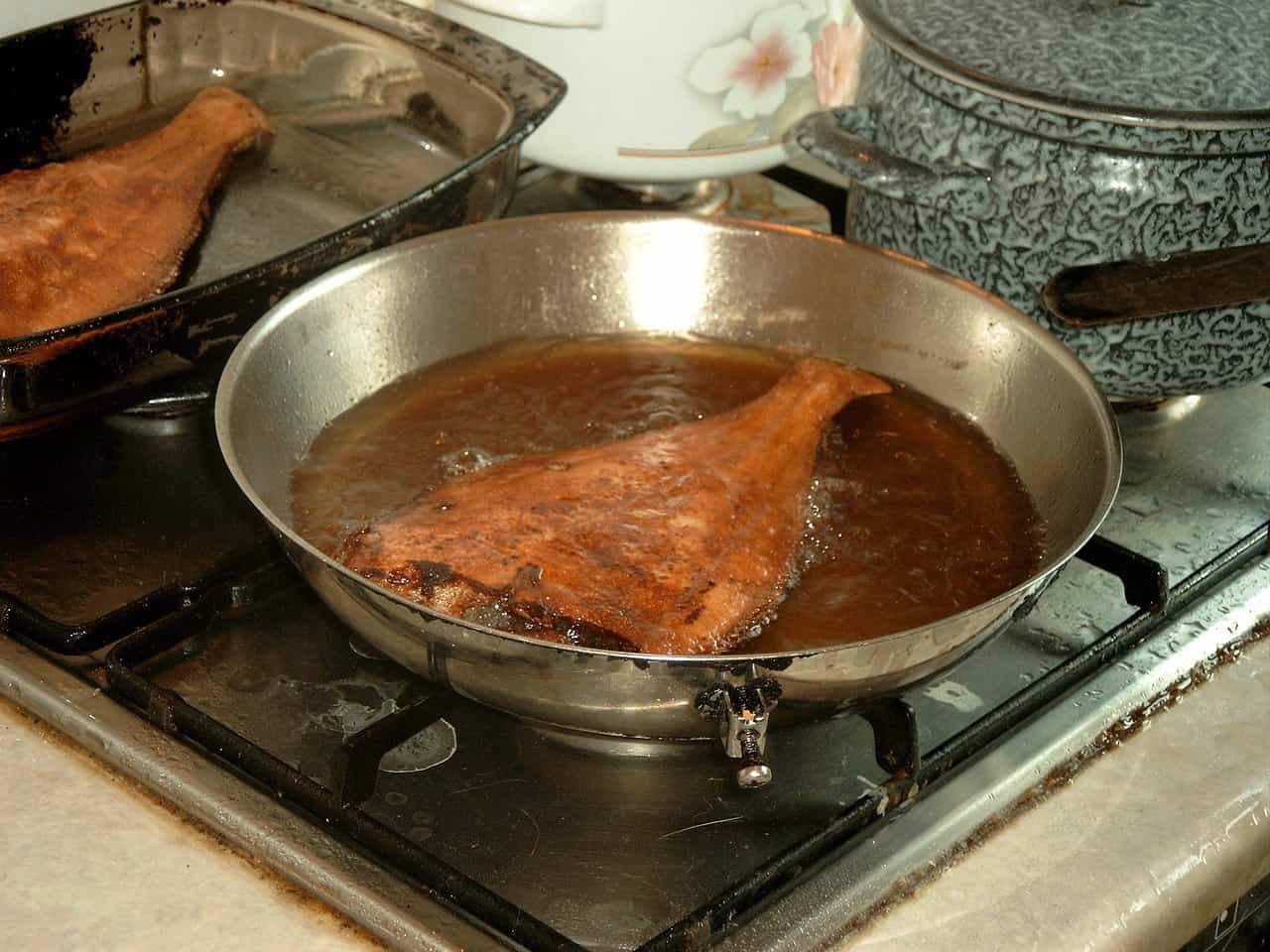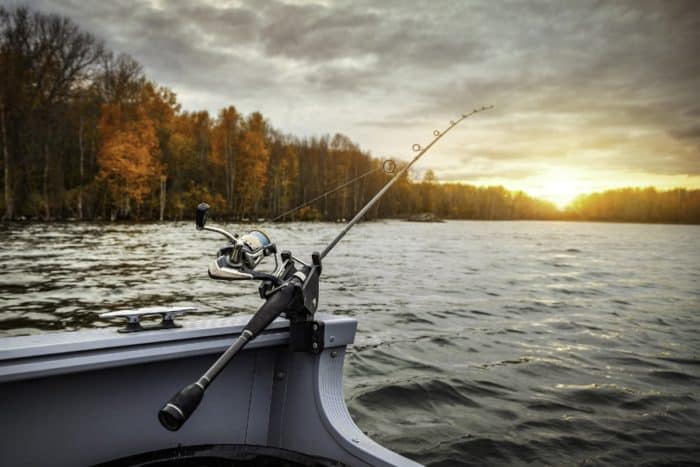Best Oil to Fry Fish: How to Choose
If you don’t use the right type of oil to fry your fish, the fish can turn greasy or leathery, which is the last thing you want to have happened. So, what’s the best oil to fry fish? Keep reading to learn about all the things you need to know when frying fish, all the oil options, and some general tips on how to fry the best fish.
Best Oil to Fry Fish
To guide you into making the right decision about the best oil to fry fish, here are four oils that are the best for frying fish, their smoke points, and a couple of benefits to using them.
1. Canola Oil
Canola oil is by far one of the best oils to fry fish. It’s a very light oil that can easily be found in grocery stores, and it’s affordable. Canola oil has a neutral flavor and is the best oil to fry fish because there’s no risk of it overshadowing the taste of your fish.
It also has a high smoke point, and because it is highly refined, canola oil is very stable. It contains high levels of omega-6 and -3 fatty acids, which makes it a healthy oil option.
Smoke point: 400 degrees
2. Avocado Oil
Avocado oil is a great choice if you’re looking for a healthy option. It’s high in Vitamin E and has a good fat balance. It also has a high smoke point, which works well if you’re battering or deep frying fish.
The biggest drawback to avocado oil is the price – particularly if you’re deep frying, which is a process that uses a large amount of oil.
Smoke point: 520 degrees
3. Cottonseed Oil
Cottonseed oil has an extremely high smoke point and is affordable. It’s so affordable that those who need to buy in bulk won’t have any issues with the price.
Smoke point: 450 degrees
4. Coconut Oil
Coconut oil is another healthy option that you can pick to fry your fish in. Coconut oil does have a very distinct and present flavor in it, so be aware of that when using it as it will add a coconut flavor to your fish.
Smoke point: 450 degrees
5. Sunflower Oil
Sunflower oil is made from pressing the sunflower seeds and is a common oil for frying food because it has a neutral flavor that won’t interfere with the fish flavor. It’s considered one of the best oils for frying fish because it makes fried fish crispy and light.
When you buy sunflower oil, opt for the refined varieties because they have a much higher smoke point.
Smoke point: 450 degrees
6. Safflower Oil
Refined safflower oil has the highest smoke point on this list: 510 degrees. This makes it a great choice for frying fish. It’s also a great choice because it’s neutral in flavor and will leave the taste of your fish unaffected and bright.
Smoke point: 510 degrees
7. Vegetable Oil
Vegetable oil is by far the most popular choice for frying fish. Not only is it extremely affordable, but it also has a very neutral taste. You should know about vegetable oil because it’s often a mixture of oils, including canola oil, sunflower oil, soybean oil, palm oil, etc.
When buying vegetable oil for frying fish, make sure to check the smoke point on the bottle because it can vary.
Smoke point: 400 degrees
8. Peanut Oil
If you don’t mind a slightly nutty flavor, peanut oil is a great option for frying fish. It’s worth noting that the nutty flavor is so mild that the taste is considered neutral. Peanut oil is an extremely affordable oil. It’s also great at preventing flavor transfer. However, peanut oil isn’t the healthiest option on this list.
Smoke point: 450 degrees
Best Fish for Deep Frying
There are so many different types of fish, but not every single one is great for frying. When choosing which fish you should fry, look for options with neutral flavors, and aren’t too oily. A good rule of thumb is that it’s typically good for frying if it has white flesh.
Here is a list of some of the best fish to fry:
- Shrimp
- Perch
- Trout
- Striped bass
- Halibut
- Catfish
- Alaskan cod
- Tilapia
When picking which fish you should fry, lean and neutral flavored fish are the best to go with. There are so many freshwater options to go with, including catfish, trout, and bass. You should stay away from sea bass, salmon, or tuna when frying because they’re dense and oily, which isn’t compatible with frying.
Things to Consider When Choosing the Best Oil to Fry Fish
The kind of oil you use to fry your fish can greatly impact how the fish fries, the texture, and the overall taste. So, you must choose the right oil.
Below you’ll find three of the biggest things you need to think about when picking the best oil to fry fish:
- Smoke Point: The smoke point is the temperature at which oil starts to break down and become unstable. When you deep-fry fish, you want to use oil with a high smoke point because you have to fry fish at high temperatures.
- Flavor: Fish is a delicate piece of meat. So, you want to pick an oil that has a neutral flavor that won’t be overpowering.
- Transfer of Flavor: If you’re planning on frying different types of fish simultaneously, you want to find an oil that won’t transfer the flavors of the different fish.
Refined vs Unrefined Oils
There is a significant difference here and understanding that difference will help in both choosing what oil is right for your cooking needs as well as flavor. A refined oil is one that has been bleached or deodorized after its extraction. Oils treated this way lose the majority of their smell, color and distinct flavors.
Unrefined, on the other hand, means that it has not been touched since the extraction process (in other words, nothing has been added or removed from it). Unrefined oils taste like the plant they have been extracted from, which is important depending on how you’ll be using it.
Refined oils aren’t necessarily bad for you, they will just have different smells and colors. To give you a better sense of which oil is right for you, here’s an example. If you don’t like the taste of avocado or just don’t want an avocado flavor added to your dish while cooking, then you should probably go with a refined avocado oil. It will have a much more subtle taste than the unrefined version. Whereas, if you do prefer an avocado flavor, then an unrefined oil would be a great option.
Tips for Frying Fish
After figuring out what the best oil to fry fish is, you need to decide how you’re going to fry your fish. Below are some general tips for frying fish that will help you serve delicious and flaky fish every time.
- Fish is a delicate piece of meat, and when it gets exposed to high temperatures, it can turn tough and leathery. To avoid this, make sure that you coat the fish in batter before you fry it. The batter protects the fish from the hot oil and seals the moisture inside, ensuring that you have a moist and perfectly cooked piece of fish.
- You want to make sure that you’re cooking your fish at the right temperature. If the temperature is too low, the oil can absorb a lot of oil and become greasy. Too high, and the fish and batter will burn and be scorched. The best temperature for frying fish is 360 to 380 degrees.
- If you’re cooking more than one batch of fish, make sure that your fryer is set to the right temperature. If you want to prevent your fryer from cooling down between batches, you can set it to a higher temperature.
- Fry in small batches regardless of what oil you end up using. If you fry too many fish pieces at a single time, the results won’t be good. It’s best to commit to frying fewer pieces simultaneously, even if it does mean taking longer to finish frying it.
How to Pan Fry Fish
While deep frying fish is very common, what do you do if you don’t have a deep fryer? Well, you can choose to pan-fry your fish using vegetable oil. Here’s how to do it:
Step 1: Prepare the Fish
You’ve got your fish ready to go, so now it’s time to get it prepped for frying. You can choose to fry it as is (if you’re pan-frying) or dredge it in breadcrumbs or flour. By coating your fish, you’re adding more body and texture, but the choice is up to you.
Dredging in Breadcrumbs or Flour
If you’ve decided to dredge your fish in breadcrumbs or flour, start by dipping the fish into the breadcrumbs, then into the egg, and then back into the breadcrumbs. This ensures that you’ll get a nice crispy fish at the end of the cooking process.
Step 2: Prepare the Pan
Prepare your pan for frying by pouring a couple of tablespoons of vegetable oil into the pan. Just as you would with deep frying, make sure that the vegetable oil has a high smoke point. Pour enough oil into the pan so that it’s completely coated, but not so much that the fish will float. Then start warming up your pan.
Step 3: Fry the Fish
Heat your pan until the oil slides easily around the pan. To test the heat of the oil, drop in a couple of drops of water. You will know the oil is ready if the water makes it pop.
Place the fish flesh side down in the hot pan. If your fish doesn’t have skin, then it doesn’t matter which side you cook first.
Once the fish is in the pan, slide your spatula under it to prevent it from sticking. You want to now cook the fish for approximately three to four minutes on each side. Fried fish will take about 10 minutes per inch of thickness. You want to cook your fish until the flesh turns a white color and flakes easily, or if it’s coated in flour or breadcrumbs until the coating is golden brown.
Choosing the best oil to fry fish ensures that the flavors don’t transfer from one batch to another, that the fish doesn’t get greasy, and that the flavor doesn’t overpower the taste of your fish. Ensure that you’re carefully considering all of these factors when you pick the best oil to fry fish.
Categories: Fishing












